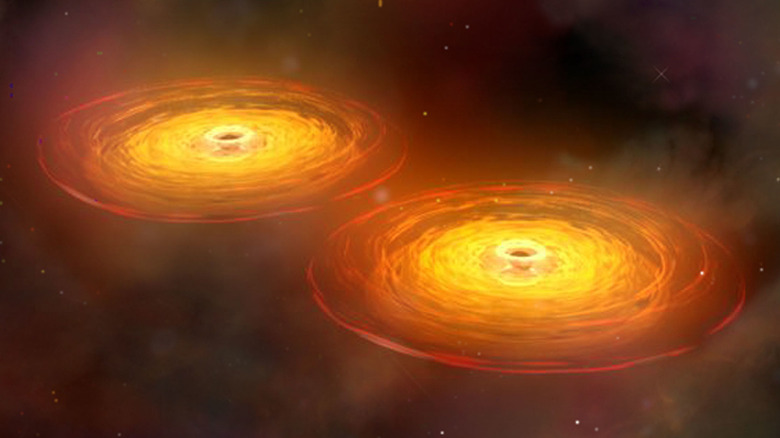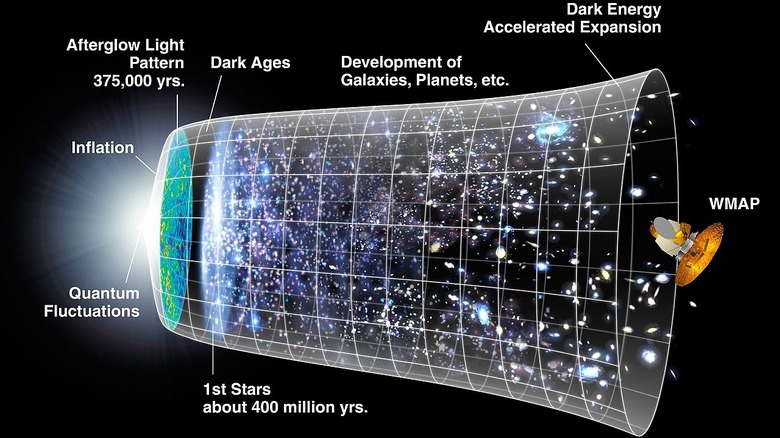The Strange Reason Why The Entire Universe Hums
Whether or not folks realize it, Earth is constantly bombarded with particles and waves of all types from all sources across the cosmos. Electromagnetic waves from the sun take about 8 minutes and 20 seconds to reach Earth and include much more than the narrow bandwidth of wavelengths that produce visible light. As the Science Learning Hub shows, we've got very short waves like gamma rays and x-rays, long waves like microwaves and radio waves, and everything in between. Plasma from the sun — aka, solar wind — gets redirected by Earth's magnetic field and becomes beautiful auroras, per the website Space. Meanwhile, cosmic radiation from space in the form of charged particles get deflected by our atmosphere nonstop, per CERN. Then there are neutrinos, which are so small that they pass through literally everything. Every single second, 100 trillion of them pass through the human body, per Smithsonian Magazine.
Now we can add one more ambient cosmic phenomenon to the list of things that strike Earth 24-7: gravitational waves. Gravitational waves don't fly through space like particles, however — they're composed of space itself. Think of space like a bedsheet that constantly hums and you might get the right idea. In fact, Smithsonian Magazine explains that spacetime is always humming. Waves of gravity ripple through the universe in the background, and we can detect them when they pass through really big objects similar to ocean waves rolling through floating buoys. As for the cause of gravitational waves? We've got no idea.
Gravitational waves rippling across space
The recent discovery of constant, universal gravitational humming comes on the heels of another recent discovery made in 2015. It took nearly a full 100 years — from 1916 to 2015 — for researchers to detect and measure what Einstein predicted in his Theory of General Relativity at the beginning of the 20th century: the mere existence of gravitational waves at all. As New Scientist explains, scientists at the Laser Interferometer Gravitational-Wave Observatory (LIGO) directly observed gravitational waves coming from a pair of black holes 1.3 billion light years away merged into one, new black hole in 2015. The event disturbed spacetime to such a great extent that gravitational waves from the event impacted Earth. This was the first time in history we witnessed such an event, even though gravitational waves were indirectly observed back in 1974.
The new find about ambient, incessant, gravitational wave humming builds on 2015's milestone. It also results from 15 years of observations and studies from multiple, independent teams in China, Europe, Australia, India, and North America, per Smithsonian Magazine. All of these teams discovered the same thing, which goes very, very far in corroborating the find. The North American team's results, published in The Astrophysical Journal Letters, not only describe gravitational waves as permeating the fabric of spacetime but having an entire spectrum of wavelengths similar to the electromagnetic spectrum. The data comes from direct observation of 67 different pulsars, stars that went supernova and collapsed into pulsating neutron stars.
[Featured image by NASA/CXC/A.Hobart via Wikimedia Commons | Cropped and scaled | Public Domain]
Rippling since the beginning of time
If you couldn't guess from how long it's taken to discover and observe gravitational waves, they're extremely tricky to measure. Space explains that pulsars are ideal candidates for detecting gravitational waves. Pulsars spin, and when their magnetic poles point our way, the poles flicker at a constant, clock-like rate of 700 times per second.
By aggregating data from many different pulsars, researchers discovered that the pulses arrived at Earth at different times. This isn't because of cosmic dust interfering with the transmission of light, but because of gravitational waves colliding with pulsars and interrupting the regularity of their flickers. Differences ranged from nanoseconds to five years or more, which is why the current study took 15 years to complete. In the end, gravitational waves constantly bombard not only pulsars but every other cosmic body, too. It just so happens that pulsars are the perfect tool to measure them. National Geographic says that each wave is "trillions of miles" long.
The 2015 gravitational wave formed from the merger of two black holes an easy-to-spot origin. But the waves that continually ripple through spacetime? We don't know their source. New Scientist says that they could be leftover from the Big Bang, just vibrating and vibrating endlessly. "Defects" in the inflation of the early universe could have spread waves of gravity throughout the cosmos, like wrinkles that won't ever flatten. Further research could help reveal even more secrets about the origins of our universe.
[Featured image by NASA/WMAP Science Team via Wikimedia Commons | Cropped and scaled | Public Domain]


